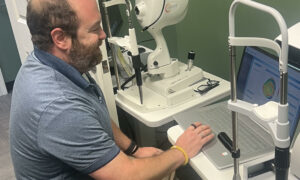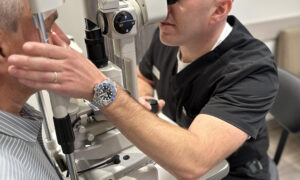
Dr. Klute in one of his office’s exam rooms. Dr. Klute says there are specific actions you can take to reduce your practice’s dependency on managed care vision plans.
Making managed vision care an optional part of your practice.
By Kyle D. Klute, OD
May 8, 2024
Managed vision care (MVC): are you all in, all out or somewhere in between? One of the biggest frustrations in comprehensive, primary eyecare is dealing with managed vision care.
Stagnant reimbursements, formulary restrictions and patient perceptions of coverage are just a few annoyances most optometrists deal with on a daily basis.
On the flip side, managed vision care brings value to our practices by bringing patients to our chairs. Most cold-start practices rely heavily on MVC to attract patients early in the life of the practice. Many existing practices use MVC to continue to grow their patient base.
So, there is a definite value in using MVC. How do we resolve the tension between needing it and hating it?
The answer, from what I found, is NOT to resolve the tension, but to use it to our benefit. How? By using MVC to intentionally grow the medical side of our practices. By intentionally funneling patients to medical management we decrease our dependence on MVC for revenue.
I know that seems like I’m evading the true problem. But stay with me.
Over the last five years at my practice, I implemented a three-step plan to use managed vision care to grow the medical side of the practice with the end goal of making MVC optional. Here are the three steps.
Code & Bill Appropriately for Acute Medical Eyecare
The reason you start here is acute care is the easiest way to take care of your patients medically and separately from MVC. When patients come to you with a red eye, they understand when you tell them their appointment will be billed to medical. There is usually minimal resistance. Additionally, this is a great place to “train” your patients on the value you provide to them for care beyond glasses and contact lenses.
Other Articles to Explore
However, the mistake many optometrists make when they bill medical insurance is they undervalue their care by having fees that are too low, under-coding, or both. When either of those mistakes is made, the value in that care is unrealized, and therefore, underutilized.
In other words, if we don’t see the financial incentive of managing acute medical conditions, we will not be motivated enough to convert patients to chronic disease management in steps two and three (see below).
The best metric for knowing how we are valuing our acute eyecare is 992×3/992×4 ratio. This number can be found by adding up all the level 3 codes and dividing it by the number of level 4 codes.
The practices that manage plenty of acute and chronic medical eyecare, and bill and code appropriately, usually have a ratio around 1 to 1.5. Many practices that under-code and undervalue their care have ratios between 5 and 15.
Implement Chronic Disease Pillars
The next best step for advancing our practices toward the goal of making MVC optional is implementing specific protocols, one by one, for capturing and caring for patients with chronic eye conditions such as dry eye, diabetes, glaucoma, age-related macular degeneration, peripheral retinal disease and myopia management, etc.
We talk about capture rate in eyeglasses and contact lenses all the time. We even have specific metrics for them.We need to use that same mentality toward “capturing” our MVC patients for chronic medical eyecare. To “capture” medical eyecare patients we need to find them through intake questionnaires, pretesting and what we discuss, detect and diagnose during annual examinations.
When a symptom or sign occurs, it triggers a conversation with the patient about the concern of the condition and initiates a follow-up according to clinical practice guidelines and the practice-specific protocol.
Are there metrics to determine success in disease pillar implementation? Yes, let’s use glaucoma as an example.
Say a patient with a family history of glaucoma arrives at the office for their annual exam and one of their optic nerves appears to be thinning. Prescribe glasses and/or contact lenses and educate the patient on their risk for glaucoma and schedule them for a glaucoma evaluation in 2-4 weeks.
Clinical practice guidelines recommend annual visual fields for glaucoma suspects and annually or more for glaucoma patients.
If 2-5 percent of the population has glaucoma, and approximately 10 percent are at risk, then it should follow that we should be performing visual fields at 10 percent or more of our annual evaluations with refractions. To calculate this metric, add up the number of visual fields (92083) performed and divide by the number of refractions (92015).
Practices that are heavily medical, and adhere to practice guidelines, have visual field per refractions at 10 percent or more.
Take Care of the Total Patient
Now that we’ve maximized value in acute care and implemented several disease pillars, it is time to begin managing the patient’s chronic disease at annual exams through their medical insurance. Often, this requires seeing patients more frequently than at annual intervals, especially when they are contact lens wearers and/or have multiple chronic conditions that need additional special testing.
Total or comprehensive care occurs when we use the MVC to bring patients to the practice to constantly feed and build medical eyecare. When this becomes a continuous process, we can decide if we want to keep MVC feeding the system or drop it. How do you know? A metric, of course.
The metric, 92xx per refraction, is the best way to analyze where your practice is in the process of the above three steps and to determine if you can make MVC optional. Calculate this metric by adding up the number of 99 codes used and divide by the number of refractions performed. When this number is above 50 percent, and upwards into the 70-80 percent range, you are far less dependent on revenue from MVC and can choose to keep or lose it.
When we have the freedom to choose, we no longer hate MVC or need MVC, but use it to our advantage to provide responsible care for our patients and for the good of our practices.
 Kyle D. Klute, OD, is the founder and lead optometrist at Good Life Eyecare, a multi-location practice in Eastern Nebraska and Western Iowa. He is a co-founder of EyeCode Education’s Comprehensive Optometry Simplified, an online program to help primary care optometrists grow their medical practices. He is a fellow of the American Academy of Optometry and an editor for the Journal of Medical Optometry. Follow him on LinkedIn for daily articles, protocols and insights for medical optometry practice growth. To contact him: kdklute@gmail.com
Kyle D. Klute, OD, is the founder and lead optometrist at Good Life Eyecare, a multi-location practice in Eastern Nebraska and Western Iowa. He is a co-founder of EyeCode Education’s Comprehensive Optometry Simplified, an online program to help primary care optometrists grow their medical practices. He is a fellow of the American Academy of Optometry and an editor for the Journal of Medical Optometry. Follow him on LinkedIn for daily articles, protocols and insights for medical optometry practice growth. To contact him: kdklute@gmail.com























